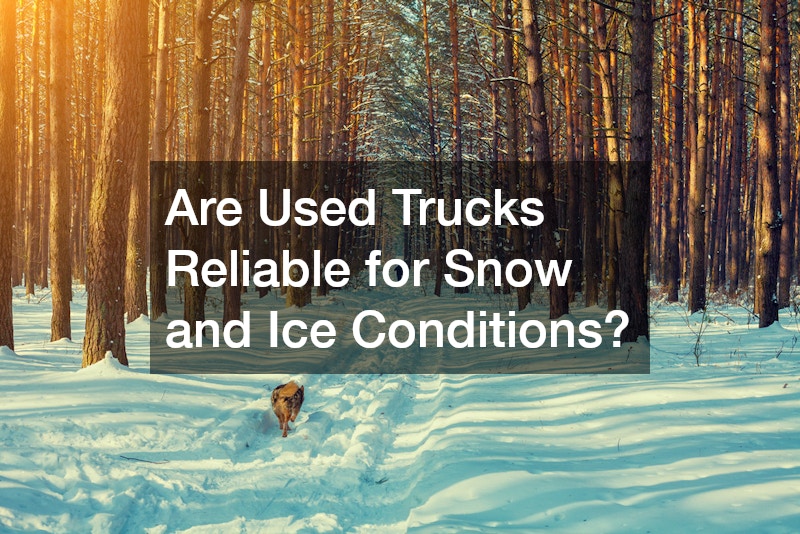Understanding how to choose the best truck for snow and ice is crucial for ensuring safety and optimal performance during harsh winter conditions. Snowy and icy roads present unique challenges, making it essential to find a truck that can handle the difficult terrain with ease. In this comprehensive guide, we’ll walk you through the most important features, performance factors, and practical considerations to help you make an informed decision.
- 1. What Features Should I Look for in a Truck?
- 2. How Important is Engine Performance in Snowy Conditions?
- 3. Is Truck Weight an Advantage in Snow?
- 4. Are Used Trucks Reliable for Snow and Ice Conditions?
- 5. How Do Tire Choices Impact Performance in Snow?
- 6. What Size Truck is Best for Snow and Icy Roads?
- 7. What Are the Technology and Safety Features to Consider?
- 8. How Can You Budget for Your New Truck?
- 9. What are The Environmental Impacts of Trucks in Snowy Conditions?
1. What Features Should I Look for in a Truck?

When searching for the best truck for snow and ice, you’ll want to focus on key features that improve traction, stability, and control on slippery surfaces. Here are some critical elements to consider:
Four-Wheel Drive Systems
A four-wheel drive (4WD) system is one of the most important features in finding the best truck for snow and ice. It provides power to all four wheels simultaneously, offering improved traction and control in slippery conditions. Trucks with part-time or full-time 4WD allow you to switch between driving modes, optimizing performance based on the road conditions.
Anti-lock Braking Systems
An anti-lock braking system (ABS) prevents the wheels from locking up when you brake, reducing the risk of skidding on icy roads. Trucks with ABS help maintain control during sudden stops, particularly when dealing with brake repair after extended use in cold weather. It’s essential to ensure that the truck’s ABS is functioning correctly, as this system can be a lifesaver in winter driving.
Ground Clearance
Ground clearance is crucial when driving through snow, especially in areas with heavy snowfall. A truck with higher ground clearance is less likely to get stuck in deep snow. Additionally, installing a lift kit can help raise the vehicle’s body, further improving its ability to navigate through snowdrifts without compromising performance.
Traction Control
Traction control systems (TCS) monitor each wheel’s grip and adjust the power distribution to reduce slipping. Trucks with advanced traction control are less likely to lose control on icy roads, giving you more confidence in challenging conditions.
Winter Tires Compatibility
Winter tires are designed to perform better in cold temperatures and offer superior grip on snow and ice. Compatibility with winter tires is a must for the best truck for snow and ice. Additionally, routine tire rotation ensures even wear and maintains optimal performance throughout the season, helping to extend the lifespan of your tires.
2. How Important is Engine Performance in Snowy Conditions?
Engine performance is a critical factor in determining how well a truck handles snow and ice. A truck’s engine power influences its ability to overcome obstacles and maintain traction in slippery conditions.
Torque and Traction
High torque provides the power needed to move through snow and maintain traction on icy roads. Trucks with high torque output are better equipped to pull through deep snow, making them ideal for winter driving.
Fuel Efficiency vs. Power
While power is important, balancing it with fuel efficiency is key, especially during winter when vehicles tend to consume more fuel. The best truck for snow and ice should offer a good combination of fuel efficiency and power, ensuring you’re not constantly refueling during long winter drives.
Turbocharged Engines
Turbocharged engines provide additional power by forcing more air into the engine, which can improve performance in cold weather. A turbocharged truck can offer quicker acceleration, helping you navigate slippery roads more effectively.
Diesel vs. Gasoline
Diesel engines typically provide more torque than gasoline engines, which can be beneficial for driving in snow and ice. However, gasoline engines often start more reliably in extremely cold temperatures. Consider your region’s climate when choosing between the two.
Engine Displacement
Engine displacement refers to the size of the engine and its ability to generate power. Trucks with larger engines tend to have more power, but this may come at the expense of fuel efficiency. In snowy conditions, a balance between engine displacement and overall weight can make all the difference.
3. Is Truck Weight an Advantage in Snow?
The weight of a truck can significantly affect its stability and traction in snow and ice. Heavier trucks are generally the best trucks for snow and ice as they provide better stability. However, there are pros and cons to consider.
Heavier Trucks and Stability
Heavier trucks are typically more stable on snow and ice, reducing the likelihood of sliding or skidding. However, they may struggle with fuel efficiency and agility on icy roads.
Weight Distribution
Proper weight distribution is crucial for winter driving. If the rear of the truck is too light, it can lead to poor traction. You can improve weight distribution by adding weight over the rear axle, such as sandbags, for better traction in slippery conditions.
Adding Weight for Traction
Many drivers add weight to their truck beds to improve rear-end traction on icy roads. This simple technique can help trucks perform better in snow and ice, preventing the rear wheels from slipping as much.
Pros and Cons of Lightweight Trucks
While heavier trucks offer better stability, lightweight trucks are often more fuel-efficient and easier to maneuver. For icy roads, this maneuverability can be a valuable asset.
Payload Considerations
A truck’s payload capacity can influence its performance in snow. While it’s important to avoid overloading your vehicle, maintaining a balanced payload can enhance stability and traction.
4. Are Used Trucks Reliable for Snow and Ice Conditions?

Purchasing a used truck can be a cost-effective option, but it’s essential to ensure it’s equipped to handle winter driving.
Key Considerations for Used Trucks
When considering a used truck, inspect key winter features such as 4WD, ABS, and traction control systems. You’ll also want to verify the vehicle’s maintenance history and ensure it’s equipped with winter-ready tires.
Inspecting Winter Features
When evaluating a used truck, inspect its winter features carefully. Trucks that have been well-maintained are more likely to handle snow and ice with ease. Consider the availability of roadside assistance in case of emergency situations while driving in harsh conditions.
Pros and Cons of Buying Used
Buying a used truck from a reputable source, such as an auto body shop, can save you money while still offering the winter performance you need. However, it’s important to weigh the risks of wear and tear that may come with a used vehicle.
Cost-Benefit Analysis
The cost of buying a used truck should be compared to the benefits of newer safety and performance technologies. While a used truck may be cheaper upfront, investing in modern safety features may be worth the additional cost.
5. How Do Tire Choices Impact Performance in Snow?
Tires play a critical role in determining which is the best truck for snow and ice.
Importance of Winter Tires
Winter tires are specifically designed for cold weather, with deeper treads and softer rubber compounds that provide better traction on snow and ice. They are essential for the best truck for snow and ice.
All-terrain vs. Snow Tires
All-terrain tires can perform well in light snow but may not offer the same level of grip as dedicated snow tires. Snow tires are specifically engineered to handle icy and snowy conditions, making them a better choice for areas with harsh winters.
Tire Pressure and Traction
Maintaining the right tire pressure is crucial for optimal performance in snow. Cold temperatures cause tire pressure to drop, which can affect traction. Regular checks and adjustments are essential for safe winter driving.
Tire Maintenance in Winter
Regular tire maintenance, including tire rotation, ensures even wear and maximizes the lifespan of your tires. Properly maintained tires improve traction, making it easier to navigate icy roads safely.
6. What Size Truck is Best for Snow and Icy Roads?
Choosing the right size truck depends on the terrain and driving conditions. The best truck for snow and ice will often depend on your location and how severe the weather will be.
Full-size Trucks
Full-size trucks offer more power and higher ground clearance, making them well-suited for deep snow. They are often equipped with robust 4WD systems, but their larger size can make maneuvering on icy roads more challenging.
Mid-size Trucks
Mid-size trucks strike a balance between power and maneuverability. They offer good ground clearance and handling without being as bulky as full-size models, making them a versatile option for winter driving.
Compact Trucks
Compact trucks are easier to handle in tight spaces and may be more fuel-efficient, but they may lack the power and ground clearance needed for severe winter conditions.
Maneuverability and Visibility
In snow and ice, maneuverability and visibility are key to safe driving. Trucks with good visibility and responsive steering are easier to control on slippery roads, reducing the risk of accidents.
7. What Are the Technology and Safety Features to Consider?

Modern trucks come equipped with advanced safety technologies that can significantly improve performance in snow and ice.
All-wheel Drive Systems
All-wheel drive (AWD) provides power to all four wheels automatically, improving traction and stability. AWD systems are especially beneficial in snowy conditions, and if you ever get stuck, a towing service can help you out.
Electronic Stability Control
Electronic stability control (ESC) helps prevent skidding by adjusting the brakes and engine power. This technology is essential for maintaining control on icy roads.
Ice Warning Sensors
Some trucks are equipped with ice warning sensors that detect when temperatures drop near freezing, alerting the driver to potential icy conditions.
Adaptive Headlights
Adaptive headlights adjust to changing road conditions, improving visibility in snowy weather. They are especially useful when driving in low-visibility conditions such as snowstorms or fog.
Blind Spot Monitors
Blind spot monitors enhance safety by alerting drivers to vehicles in their blind spots, reducing the risk of collisions in snowy or icy conditions.
8. How Can You Budget for Your New Truck?
Investing in the best truck for snow and ice requires careful financial planning.
Evaluating Initial Cost vs. Long-term Value
While the initial cost of a truck may seem high, the long-term value should be considered. Trucks that offer superior performance in snow and ice may save you money on repairs and mechanic shop visits in the long run.
Financing Options
Many dealerships offer financing options to make purchasing a truck more affordable. Be sure to compare rates and terms to find the best deal.
Maintenance and Repair Costs
Winter driving can take a toll on a truck, so factor in maintenance and repair costs when budgeting. Regular inspections and timely repairs can extend your truck’s lifespan and improve its winter performance. It is important to factor in costs to detail your truck when necessary. Fortunately, most areas have a local auto detailer who provides this service at a fair cost.
Insurance Considerations
Insurance premiums for trucks may vary based on factors like size, engine type, and safety features. Trucks equipped with winter-ready features may qualify for lower insurance rates, as they are considered safer in harsh conditions.
Evaluating Add-ons and Accessories
Consider whether add-ons like paint protection film or snowplows are necessary for your truck. While these accessories can increase the initial cost, they may enhance the truck’s performance and longevity in snowy conditions.
9. What are The Environmental Impacts of Trucks in Snowy Conditions?

Winter driving can affect both the environment and your truck’s performance.
Fuel Efficiency in Winter
Cold temperatures can reduce fuel efficiency, as engines take longer to warm up and must work harder to maintain performance. Choosing a fuel-efficient truck can help minimize this impact.
Emissions Control Systems
Trucks with advanced emissions control systems produce fewer pollutants, making them more eco-friendly options for winter driving.
Eco-friendly Trucks for Snow
Hybrid and electric trucks are becoming more popular for winter driving due to their lower emissions and efficient performance in cold conditions. These trucks may also qualify for government incentives.
Impact of Road Salts
Road salts used to melt snow can corrode a truck’s exterior. Consider using auto body paint or applying a paint protection film to protect your truck from the harmful effects of road salts.
Minimizing Carbon Footprint
You can minimize your truck’s carbon footprint by opting for eco-friendly models, maintaining your vehicle regularly, and reducing unnecessary idling in cold weather.
Selecting the best truck for snow and ice requires careful consideration of features such as four-wheel drive, anti-lock brakes, ground clearance, and winter tire compatibility. Engine performance, weight distribution, and safety technologies also play a significant role in a truck’s ability to handle winter roads. Whether you’re buying new or used, make sure to budget for long-term costs like maintenance and repairs. By understanding these critical factors, you’ll be well-prepared to choose a truck that will keep you safe and comfortable during the winter months.
